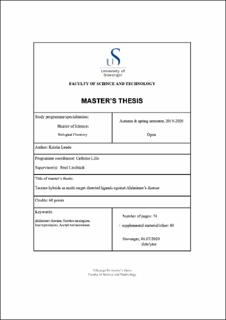Tacrine hybrids as multi-target-directed ligands against Alzheimer’s disease
Master thesis
Permanent lenke
https://hdl.handle.net/11250/2680145Utgivelsesdato
2020-07Metadata
Vis full innførselSamlinger
Sammendrag
World health organization estimates that nearly 9.9 million people develop dementia each year. Alzheimer disease (AD) is the most common form of dementia, and contributes to 60-70% of the cases. In addition to affecting the patient s families AD also represents substantial costs to society.
It has been discovered that deterioration of neurons in the early stages of AD is parallel to reduced levels of the neurotransmitter acetylcholine (ACh). AChE, which is responsible for regulating ACh concentration, has also been revealed to contribute to the formation Aβ aggregation, another brain change associated with AD. Aβ aggregation contributes to degradation of neurons by blocking nutrient supply. Multiple compounds have been synthesised with the purpose of preventing AChE-induced Aβ aggregation in addition to preventing hydrolyse of ACh. Among them are tacrine heterodimers.
Herein, by combining tacrine and isocryptolepine, two new tacrine heterodimers have been synthesized. The heterodimers (1a and 1b) commenced from azides-alkyne click- chemistry reaction between propagylated isocryptolepine precursor and azide armed tacrine.
The evaluation of 42 tacrine analogues, suggested as potential AD treatments, are also featured. Affinity towards AChE and BChE, ability to inhibit self-induced and AChE- induced Aβ aggregation is assessed. Also, interaction with PAS is analyzed by molecular modeling studies. Compound 12 and 28 proved to give good results in all the evaluated categories.
Beskrivelse
Master's thesis in Biological Chemistry
